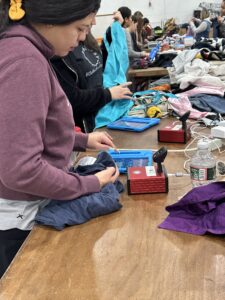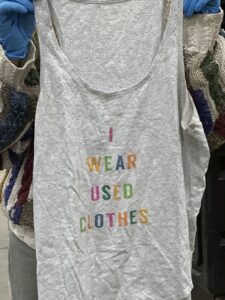
How CSMM is Leading New York’s Journey Towards a Circular Economy
In today’s fast-paced, consumption-driven society, textile waste has become one of the fastest-growing categories in the U.S. waste stream. New York State (NYS), with its robust economy and thriving fashion industry, is at the epicenter of this issue. Recognizing the urgent need for action, the Center for Sustainable Materials Management (CSMM) has proactively addressed the challenge by commissioning a comprehensive study on textile waste diversion in NYS. This research, conducted by our Resource Recycling Systems (RRS) team, is a critical step in helping policymakers, industry leaders, and citizens reimagine how textiles are managed at the end of their life.
At the core of CSMM’s mission is inspiring and leading initiatives that challenge outdated perceptions of waste. Through this study, we have delved deep into the complexities of textile recovery, uncovering both the barriers and the opportunities that could shape the future of sustainable materials management across the state.
Download Textile Recovery in New York State Report
Understanding the Textile Waste Landscape in NYS

The study, led by our textile experts at RRS, sought to thoroughly examine textile waste in New York. It quantified the amount of textile waste generated, assessed consumer behaviors, and characterized the materials flowing through the state’s current collection infrastructure. By clarifying these areas, CSMM aims to provide a foundation for future strategies that will help New York realize its ambitious sustainability goals.
In fact, the results of the study are expected to influence key policy decisions, guide future investments, and help shape tan
gible interventions that will improve recovery rates for textiles. CSMM has consistently demonstrated its leadership in challenging how we procure, consume, and dispose of materials—and this report is no exception.
Breaking Down Barriers to Recovery
Despite the existing programs aimed at diverting textile waste, the research revealed several hurdles that impede more widespread recovery. Convenience, consumer awareness, and gaps in the recovery infrastructure are just some of the obstacles highlighted in the report. Yet, the study also identified clear pathways for progress, offering recommendations that, if implemented, could dramatically increase the rate of textile diversion in the state.
One of the standout aspects of this study is its focus on supply chain transparency and the need for more robust data collection. With sufficient information, we can craft effective strategies.
This is where CSMM’s leadership shines: they are not just identifying the problems but guiding the conversation on how to solve them.
Guiding New York Toward a Circular Future

Partnering with RRS, CSMM is pushing forward with a solutions-based mindset. Their research already serves as a blueprint for future policies and initiatives, including Extended Producer Responsibility (EPR) legislation, which could be transformative for the state’s textile recovery system. The report’s findings, which address critical areas such as consumer engagement, infrastructure gaps, and best practices, provide a roadmap for New York to move towards a circular economy for textiles.
Marisa Adler, Senior Consultant at RRS, quote ” This report is a first-of-its-kind jurisdictional profile of textile recovery practices and infrastructure. Findings are key to planning sector advancements to meet pressing sustainability needs now and into the future, including Extended Producer Responsibility (EPR) legislation, end market development, and programs and services to increase textile recovery. I’m excited to see CSMM lean into solutions development and lead the way with a model that other states can adopt.”
As Kate Walker quote, “Key to our Center’s mission is redesigning how we manage materials in New York and collaborating with the complex, diverse groups that are responsible for its end of life. Textiles are the fastest growing category of waste in the US. and are a priority material for our Center. We are proud to launch this report with RRS, to provide a roadmap for action across the state to improve stewardship of textiles and promote sustainable textiles for current and future generations.”
Building Awareness and Empowering Consumers

CSMM’s vision extends beyond the confines of research and policy development. A key part of their strategy involves emp
owering New York’s residents to make more informed choices about textile disposal. Their Recycle Right New York Textile platform is one such initiative, providing the public with accessible guidance on how to responsibly recycle textiles. By enhancing public education efforts, CSMM is fostering a culture where consumers are equipped with the knowledge to contribute to the circular economy.
A Model for Other States
While CSMM’s focus is on New York, their leadership offers a model that other states can follow. Their ability to blend research, stakeholder engagement, and practical solutions is setting a new standard in sustainable materials management. In partnership with RRS, CSMM is not only addressing the immediate issues of textile waste diversion but is also laying the groundwork for long-term, system-wide change.
Through these efforts, CSMM is driving a shift in how we think about textiles—from disposable commodities to valuable resources. And with New York’s solid waste management goals aiming for an 85% reduction in landfill and combustion by 2050, the impact of CSMM’s work will be felt for generations to come.

The Future of Textile Recovery in New York
As New York continues its journey towards a more sustainable future, the insights from this s
tudy will play a critical role in shaping the textile recovery landscape. CSMM, in collaboration with partners like RRS, is providing the vision, strategy, and leadership needed to achieve these ambitious goals. By tackling the barriers head-on and offering clear, actionable solutions, CSMM is guiding the state—and the nation—toward a future where textile waste is no longer a problem but a resource.
Related Reports
The growth of textile waste in the United States is outpacing the growth of every other major category of waste. Take a look at our other work in textile recovery and research.
Download RRS Textile Recovery in the U.S. Report
Download Sorting for Circularity USA Report
The post Reimagining Textile Waste appeared first on Recycle.com.